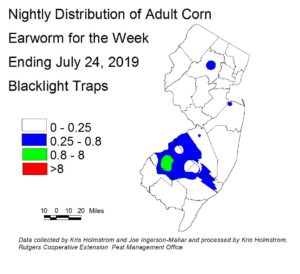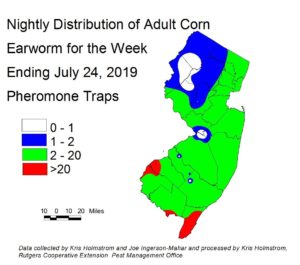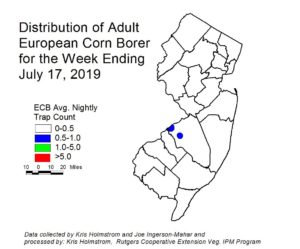 Need a food safety training certificate for a third party audit or the FSMA Produce Safety Rule? Join us on September 11th at Rutgers Cooperative Extension of Mercer County in Ewing, NJ. For more details visit our online registration page.
Need a food safety training certificate for a third party audit or the FSMA Produce Safety Rule? Join us on September 11th at Rutgers Cooperative Extension of Mercer County in Ewing, NJ. For more details visit our online registration page.
Archives for July 2019
On-Farm Food Safety Certificate Training 9/11/19
Vegetable IPM Update 7/24/19
Sweet Corn
European corn borer (ECB) moth captures have again declined to extremely low numbers, and no map will appear in this edition. Thus far, the second flight appears to be very weak, as is consistent with recent years’ second flights. Limited feeding should appear within 1-2 weeks, but may be obscured by fall armyworm (FAW) feeding by that time.
Growers should continue to scout whorl and pre-tassel stage plantings weekly and consider treating when infested plants exceed 12% in a 50 plant sample. As plantings proceed to the pre-tassel stage, ECB larvae may be found in emerging tassels. It is a good idea to treat individual plantings as they move into the full tassel/first silk stage one time. This eliminates any ECB larvae that have emerged with the tassels as they begin to move down the stalk to re-enter near developing ears.
Useful insecticides for this particular application include synthetic pyrethroids (IRAC Grp 3), spinosyns (including OMRI approved Entrust) IRAC Grp 5), and diamides such as Coragen (IRAC Grp 28) or materials such as Besiege which include the active ingredient in Coragen. Synthetic pyrethroids alone should NOT be used for corn earworm (CEW) protection on silking corn. Control with these materials is very inconsistent.
The highest nightly black light trap catches of ECB for the week ending 7/24/19 are as follows:
| Denville 2 | Old Bridge 1 |
| Dayton 1 | |
| Eldora 1 | |
| Long Valley 1 |
 Corn earworm (CEW) moth catches have remained fairly steady (but highly variable) in blacklight traps, while pheromone traps have registered significant increases in some areas over the past week (see blacklight map at left, and pheromone trap map below at right). Catches from North Carolina remain highly variable, while Delaware’s catches are similar to our southern NJ catches while also exhibiting wide variability. While none of these catches indicate that a large scale migratory influx is underway, the trend has been gradual increase with scattered hot-spots. Red areas on the on the pheromone trap map indicate a 3-day silk spray schedule, while green indicates a 4-5 day silk spray
Corn earworm (CEW) moth catches have remained fairly steady (but highly variable) in blacklight traps, while pheromone traps have registered significant increases in some areas over the past week (see blacklight map at left, and pheromone trap map below at right). Catches from North Carolina remain highly variable, while Delaware’s catches are similar to our southern NJ catches while also exhibiting wide variability. While none of these catches indicate that a large scale migratory influx is underway, the trend has been gradual increase with scattered hot-spots. Red areas on the on the pheromone trap map indicate a 3-day silk spray schedule, while green indicates a 4-5 day silk spray  schedule. Blue areas represent a 5-6 day schedule, and white areas are 6-7 day. There are far fewer CEW pheromone traps than blacklights, and the resulting map has much broader color bands as a result. It should also be noted that the pheromone traps are much more sensitive than blacklights. Therefore, the number of moths caught in pheromone traps required to generate a specific spray interval is much higher than the number caught in blacklight traps. It must be stressed that there is high variability in these catches, and growers should consult with their IPM practitioner on recommended spray schedules.
schedule. Blue areas represent a 5-6 day schedule, and white areas are 6-7 day. There are far fewer CEW pheromone traps than blacklights, and the resulting map has much broader color bands as a result. It should also be noted that the pheromone traps are much more sensitive than blacklights. Therefore, the number of moths caught in pheromone traps required to generate a specific spray interval is much higher than the number caught in blacklight traps. It must be stressed that there is high variability in these catches, and growers should consult with their IPM practitioner on recommended spray schedules.
Hackettstown Livestock Auction Results for July 23, 2019
This auction sells: lambs, sheep, goats, calves, beef cattle, pigs, rabbits, and all types of heavy fowl. Auctions are held every Tuesday with the first sale beginning at 10:30 am and ending at the last sale 5:30 pm. Hay, straw, grain, and firewood are also for sale.
Farm Fresh Eggs available for purchase by the case (30 doz.) or by the flat (2&1/2 doz.) in the main office Tuesday, Wednesday & Thursday. Also available some Monday’s and Friday’s but please call office first (908)-852-0444.
Click on link for July 23 sale results:
Cucurbit Downy Mildew Alert – 7/19/19
Cucurbit downy mildew has been reported on winter squash near Glassboro in southern New Jersey (Gloucester County). This is the third report of CDM this growing season in the state. All cucurbit growers are encouraged to scout fields on a daily basis and begin preventative fungicide programs if already not initiated.
Fruit IPM for 7/17/19
Peach:
Oriental Fruit Moth: Treatments for the 3rd generation OFM are timed for now and over the next week, depending on which county you are in. [Read more…]
Vegetable IPM Update 7/17/19
Sweet Corn
 There have been very modest increases in European corn borer (ECB) moth captures this past week. Most measurable catches occurred in central and northwestern Burlington County (see ECB map at left). These individuals represent a second flight. The next 2 weeks will give us an indication of how significant this flight will be. In recent years, the second and later flights have been very low. New feeding should appear within 2 weeks, but may be obscured by fall armyworm (FAW) feeding by that time.
There have been very modest increases in European corn borer (ECB) moth captures this past week. Most measurable catches occurred in central and northwestern Burlington County (see ECB map at left). These individuals represent a second flight. The next 2 weeks will give us an indication of how significant this flight will be. In recent years, the second and later flights have been very low. New feeding should appear within 2 weeks, but may be obscured by fall armyworm (FAW) feeding by that time.
Growers should continue to scout whorl and pre-tassel stage plantings weekly and consider treating when infested plants exceed 12% in a 50 plant sample. As plantings proceed to the pre-tassel stage, ECB larvae may be found in emerging tassels. It is a good idea to treat individual plantings as they move into the full tassel/first silk stage one time. This eliminates any ECB larvae that have emerged with the tassels as they begin to move down the stalk to re-enter near developing ears.
Useful insecticides for this particular application include synthetic pyrethroids (IRAC Grp 3), spinosyns (including OMRI approved Entrust) IRAC Grp 5), and diamides such as Coragen (IRAC Grp 28) or materials such as Besiege which include the active ingredient in Coragen. Synthetic pyrethroids alone should NOT be used for corn earworm (CEW) protection on silking corn. Control with these materials is very inconsistent.
The highest nightly trap catches of ECB for the week ending 7/17/19 are as follows:
| Califon 1 | Folsom 1 | Milltown 1 |
| Cinnaminson 1 | Green Creek 1 | Sergeantsville 1 |
| Crosswicks 1 | Hillsborough 1 | |
| Dayton 1 | Medford 1 |
